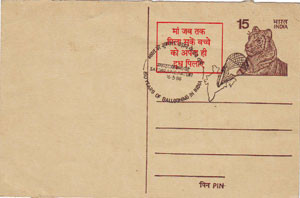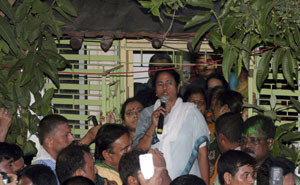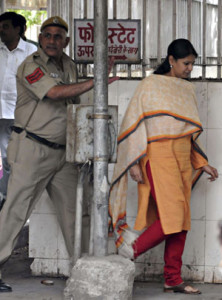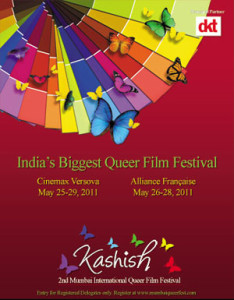Day of the Minorities
By Sujoy Dhar | News & Politics | Opinion | Viewpoint | Published 14 years ago
 India’s Communist Slayer
India’s Communist Slayer
A few months ago in an article for Newsline, I had discussed the rise of the extreme Left — the Maoists in India — and the waning popularity of the mainstream Left. The predictions of a Left debacle came true when in May a 34-year-old government in the West Bengal state of eastern India was dislodged by a feisty woman leader who rose from a humble plebeian background and finally seized power after a relentless struggle of more than two decades.
The spartan-living Mamata Banerjee’s only aim in life was to unseat the Communists of Kolkata. While governments came and went in every state of India, West Bengal, of which Kolkata is the capital, was an exception, owing to the stranglehold of the Communists in the region for three decades and an opposition that was never thought a credible alternative which could be voted to power.
So they survived the collapse of the Berlin Wall, the fall of the Soviet Union and the strong winds of capitalism as a result of globalisation. The choice for people in Bengal was actually little more than a rock and a hard place — owing to the ragtag opposition — and they decided to elect to power the known devil again and again even as the state’s health and education system remained in shambles. So, a historic win in a state of 90 million people of the firebrand Mamata Banerjee of a regional party called the Trinamool Congress, a breakaway group of India’s ruling Congress, marked a historic defeat of the Left. They also lost in the southern most state of Kerala this year and are now confined to the tiny northeastern state of Tripura bordering Bangladesh.
 Ironically, what proved dearest for the Marxists of Bengal, is what is advertised as the “cheapest automobile worldwide.” It is the land they had forcibly seized for the ultra-cheap Nano car factory of Tata Motors that engendered the decline, as the wonder car took them for a ride into the political wilderness. In an assembly of 294 seats they were reduced to 62 from the 235 seats they had won in 2006. But that should not have been entirely surprising. The run-up to the elections this year registered four years of killings, rapes, arson attacks and political clashes.
Ironically, what proved dearest for the Marxists of Bengal, is what is advertised as the “cheapest automobile worldwide.” It is the land they had forcibly seized for the ultra-cheap Nano car factory of Tata Motors that engendered the decline, as the wonder car took them for a ride into the political wilderness. In an assembly of 294 seats they were reduced to 62 from the 235 seats they had won in 2006. But that should not have been entirely surprising. The run-up to the elections this year registered four years of killings, rapes, arson attacks and political clashes.
While in the South Indian state of Tamil Nadu, iron-lady J. Jayalalitha swept to power, defeating her scam-ridden rival party run by the family of a patriarch whose relatives indulged in corruption and now languish in jail, the big story from India is the victory of Mamata Banerjee.
Mamata Banerjee proved that the Communists of Kolkata were not invincible. She also proved anything is possible, given her rise from a poverty-stricken family to chief minister of a state as vast as West Bengal, all the while retaining her squeaky-clean personal image. While South Asia is known for its patrician, pedigreed and groomed-since-birth women leaders at the helm of political affairs — beginning from Indira Gandhi to Benazir Bhutto and Sheikh Hasina of Bangladesh — the rise and fall and rise of Mamata Banerjee, who resigned as the Railways Minister last month to take over the post of West Bengal chief minister, is a rollercoaster journey of high drama and perseverance.
Immediately after she won, I was wondering how to describe her feat. And then I discovered that the story of Mamata Banerjee’s political struggle — replete with her impulsive and often anarchic actions till she matured into an astute politician who assembled the critical mass to make the final strike on the Communists — is like the story of the Hindu snake goddess Ma Manasha, the marginalised daughter of Lord Shiva who had to use all her tricks, energy and power to finally get people to worship her on earth.
The forecast of the gathering storm looming over the Communists of Bengal was made convincingly by political analysts since the time the Left antagonised the people, especially the rural masses, with their unilateralism and land acquisition policies.
A large section of people in Bengal had actually been agitating against the Communists for a long time. But Mamata Banerjee finally translated the anger against them into votes.
So now West Bengal has a new Chief Minister, a 56-year-old firebrand politician who lives an austere life in a humble dwelling with a mud-tiled roof in south Kolkata by the side of a fetid canal. Her fashion statement is a simple colourless cotton sari, a pair of Hawaiian chappals (rubber sandals) and often a cotton bag (the famous Bengali jhola) slung over her shoulder. A born fighter, she also paints, writes, recites and sings Tagore songs, all of this without the inhibition of any pseudo-cultural refinement. She is popularly known as ‘Didi,’ which means elder sister in Bengali.
The journey to the top was not however, an easy one. She not only fought the proximity of her former party, the Congress with the Leftists and organised Communists — surviving in the process a murderous attack on her during a street protest — but also the apathy and sarcasm of Bengal’s unkind and judgemental educated social class who long refused Mamata the power and respect she deserved. Her story thus parallels Manasa’s, who was refused obeisance by the arrogant merchant of Hindu mythology, Chand Saudagar, who worshipped Lord Shiva, but not his daughter.
 Genderless Jail
Genderless Jail
While Mamata Banerjee with her clean image and ascent to power is the toast of women in India (and her success is a huge filip for women in politics), India’s Tihar jail, South Asia’s largest prison complex, now houses another young woman politician after she was arrested in the 40-billion-USD telecom scandal in India — known as the 2G scam — because of the kickbacks received by politicians, including her, from the corporate sector while issuing second generation mobile service licences. She is Kanimozhi, the daughter of former Tamil Nadu chief minister M. Karunanidhi, whose party Dravida Munnettra Kazhagam (DMK) is a major coalition partner shoring up the Congress-led United Progressive Alliance (UPA) government in New Delhi.
The Indian courts did not spare Kanimozhi because of her status as a woman politician and her bail plea was rejected by a special court in Delhi and later reserved by the Delhi High Court forcing her to stay in Tihar Jail.
While issuing his verdict the judge stated, “Due to the magnitude of the crime and the nature and enormity of the allegations,” he could not show her any special consideration.
Kanimozhi, who was the urban face of the DMK party, has been held as a co-conspirator for her role in receiving massive kickbacks through the family-owned Kalaignar TV in Chennai, in which she is a stakeholder with her stepmother. The TV company she spearheaded allegedly received 214 crore rupees routed through various channels from the telecom scandal said to be scripted by her party colleague and relative A. Raja. Raja, another member of the DMK family of patriarch Karunanidhi, who had to resign as the telecom minister as the scam unfolded, is now also in Tihar Jail. India’s federal investigating agency, the Central Bureau of Investigation (CBI), holds that Kanimozhi was the brain behind the TV company.
Given Banerjee’s rise and Kanimozhi’s decline, it is clear that politics in India at this moment is a great gender leveller — only fair if women walk shoulder to shoulder with men in the political arena.

Gay and Going
Back in 1998 when India’s first lesbian-themed film Fire was released, it was greeted with arson and brickbats in the theatres of most Indian metros. Made by the exciting filmmaker Deepa Mehta, Fire was not cinema at its cerebral best, neither was the lesbian pull between two love-seeking sisters-in-law (portrayed by Shabana Azmi and Nandita Das) at the receiving end of their chauvinistic husbands’ hideous indifference convincing. But its content was explosive and bold, since it brought the issue of same-sex relationships out of the closet and into the mainstream. But Mehta had to pay a heavy price for Fire. Shooting for her next film Water was stalled by Hindu right-wing groups in the holy town of Varanasi. She did eventually shoot the period film on the plight of Hindu widows, but in Sri Lanka not India, and after a hiatus of several years.
In 2009, a landmark judgement was passed by the Delhi High Court when it struck down Section 377 of the Indian Penal Code, decriminalising homosexuality. The repercussions of the judgement were tempered and there were not many challengers. The sexual minority had won a major battle.
In May 2011, Mumbai, a city known as much for its cosmopolitan nature as its right-wing groups, hosted the second edition of a queer film festival with large heterosexual participation in two regular multiplexes. The 124 films from 23 countries on offer from May 25-29 were lapped up in KASHISH 2011 — as the festival is titled — by the lesbian, gay, bisexual and transgender (LGBT) communities and heterosexuals.
Apparently, there is a growing social acceptance of homosexuality in India. In cities like Kolkata, filmmakers such as Rituparno Ghosh are flamboyantly gay and flaunt their sexuality and effeminate bearing in their sartorial preferences. Two of his films — where he took on the role of an actor portraying gay characters — were warmly received by heterosexual audiences.
While the organisers of this year’s KASHISH 2011 believe that social attitudes towards the gay community are changing and the Delhi High Court verdict was a great social leveller, I heard an interesting interpretation by a noted social scientist. Reporting on the festival for a foreign agency, I put the question of growing tolerance for homosexuality to Mr S. Parasuraman, the director of the Mumbai-based Tata Institute of Social Sciences (TISS). He replied that society had not become more tolerant, rather it had become more individualistic and opulence-driven, to the extent that people no longer cared about other social groups, such as the gay community. He added that it was market forces that make such attitudes possible, and this is then interpreted as tolerance.


